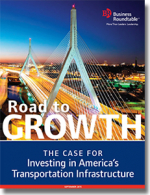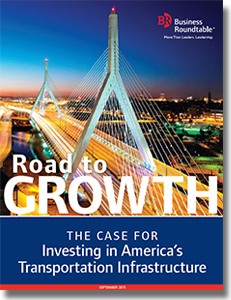The Road to Growth - The Case for Investing in America’s Transportation Infrastructure
This report outlines the economic cost of neglecting America’s transportation infrastructure and the positive effects of reinvesting in it for the 21st Century, and contrasts America’s current investment with 20th Century levels and guides policymakers forward in efforts to rebuild this vital economic foundation.
Transportation infrastructure is the backbone of a modern, competitive and productive economy.
Interrelated and mutually reinforcing transportation infrastructure systems facilitate the efficient movement of goods and services, promote trade and commerce, connect supply chains, and reduce operating costs across a diverse set of industries.
In the United States, these systems are both sprawling - covering a vast physical geography - and complex - owned, operated and funded by a diverse set of entities and jurisdictions.
This complexity makes the task of maintaining the nation’s critical infrastructure a difficult one.
And yet, the need for modernization and reinvestment in these systems cannot be overstated.
The highways, bridges, railways, airports, transit systems and waterways that once represented the best of modern architecture and engineering are deteriorating, inevitably worn down by age and stretched beyond capacity by the shifting demands of a modern economy and growing population.
Following a strong public commitment to investing in world-class physical infrastructure in the mid-20th century, public investment in most infrastructure systems has tapered off or flatlined, while demand for high-performing, high-capacity systems has grown.
Current levels of funding are far below what is needed to properly maintain, improve and expand system capacity to accommodate future demand and avoid the economic costs and inefficiencies associated with system underperformance.
Today, public investment in transportation infrastructure accounts for just 1.6 percent of gross domestic product (GDP) - a reduction from peak investment levels of 2.2 percent in the 1960s.
The cumulative impact of this underinvestment in the nation’s transportation infrastructure, the natural aging process and accelerating demand pressures is a massive gap between projected investment needs and projected investment levels over the next several years, on the order of $1 trillion by 2020.
Reinvesting in infrastructure presents policymakers with a unique opportunity to revitalize American growth.
If efficiently targeted and strategically deployed, even modest additional investment would generate significant benefits to the U.S. economy over the long term.
What’s Related


Favorites





